Suzuki has launched its weapon for the 2009 litre bike wars with the all-new GSX-R1000, and a trip to New Zealand proves that it’s ready for battle.
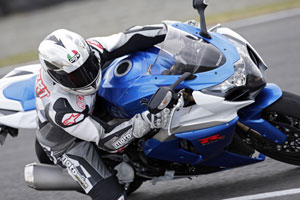
SPECIFICATIONS
ENGINE
Engine type: 999cc, 4-cylinder, 4-stroke, liquid-cooled, DOHC
Bore x stroke: 74.5mm x 57.3mm
Displacement: 999cc
Compression ratio: 12.8:1
Transmission: Six speed
Power (claimed): N/A
Torque (claimed): N/A
CHASSIS
Frame type: Twin-spar aluminium
Front suspension: Fully-adjustable 43mm inverted Showa BPF fork
Rear suspension: Fully-adjustable Showa shock absorber
Wheelbase: 1405mm
Wheels (front/rear): Five spoke aluminium alloy 17 x 3.5 / 17 x 6
Tyres (front/rear): Bridgestone BT-016 120/70ZR17 / 190/50ZR17
Brakes (front/rear): Nissin Twin 310mm discs, four-piston calipers, radially mounted / Tokico 220mm disc, single piston caliper
DIMENSIONS
Weight (claimed): 205kg dry
Seat height: 810mm
Fuel capacity: 17.5L
PURCHASE DETAILS
Price: $18,990 + orc
Colour options: Blue / White, White / Silver or Black/Matt Black
Test bike from: Suzuki New Zealand
If there’s one bike that can claim to be the king of the castle in the superbike class over the last decade it would have to be the all conquering Suzuki GSX-R1000, excelling year after year with a massively powerful engine and a solid handling package to boot.
Winning championships worldwide, the GSX-R1000 certainly has lived up to its concept of ‘The Top Performer’. But since its inception back in 2001, its changes have been limited to revisions of the original version with updates coming in 2003, ’05 and ’07.
But for 2009, Suzuki has released an all-new machine that is changed from the ground up in a bid to reclaim total domination of the litre bike class after Honda and Kawasaki released their latest incarnations of the CBR1000RR and ZX-10R last year, while Yamaha’s new big bang YZF-R1 was released earlier this year.
With a delayed release of the GSX-R1000K9, MotoOnline.com.au travelled over to New Zealand for the launch with Suzuki Australia to take part in a two day test, with a day at the high-speed Manfeild circuit and a second day touring the scenic roads of the North Island up near Palmerston North.
Even though it’s an all-new model, you could be fooled by thinking it was just an update at first glance because it does look somewhat similar to previous models. That is until you get up close and swing a leg over it for the first time.
The seat high remains the same, but the position is much closer to the handlebars than on the previous model, and it doesn’t feel as though you’re seated anywhere near as deep into the bike when in relation to the ’bars as last year’s bike.
Three-way adjustable footpegs are very handy for taller riders as you can adjust them either downwards or further back from the original setting, although the standard setting is best suited for me.
All of the controls are clean and easy to reach, although finding the S-DMS (Suzuki Drive Mode Selector) does get a little confusing at first since it’s been converted to the left ’bar from the right, while the button previously used for the S-DMS is now used to control the lap timer. Replacing the S-DMS to the left ’bar does make it much easier to scroll through the A, B and C modes though.
One of my favourite aspects of Suzuki sportsbikes has always been the instrument panel, with the large tachometer on the dash reading just over 15,000rpm, although red markers indicate that you really should be shifting at around 13,750rpm.
The dash is easy to read from the get go and revised placement of the drive mode indicator makes it clearer what mode you’re in, while Suzuki’s great gear indicator stands out as prominent as ever.
Its functionality is easy to use also, with a pair of buttons (select and adjust) making life very simple as long as you briefly read through the manual before navigating your way around the instruments.
One of the greatest steps forward this year in regards to the dash is the three engine orange rpm indicator lights that brightly standout before the white shift light flashes, and I find that setting the shift light to illuminate at 12,500 is perfect to make way for the mind lag that will usually see it flash for an extra 500rpm before your brain makes your foot click up to the next gear.
Doing the math above will then indicate to you that I like to shift at 13,000rpm on track, and that’s exactly what I do when putting the new GSX-R through its paces at Manfeild.
A short circuit at 3.0 kilometres in length, the Manfeild venue consists of considerably long straights with hard braking into tight turns, as well as a couple of decreasing radius turns that are banked and allow you to get on the gas as hard as you dare.
While I find that I can rev the engine well into the red markers up around 14,000rpm on the dash without hitting the rev limiter, I soon realise that short-shifting at around 13 grand offers the maximum balance between drive and grip.
The torque begins to set in from very low in the rev range, with the power beginning to surge at 8,000rpm before it takes off like a missile as it creeps over 10,000rpm all the way until the shift point.
To say that the power curve of the K9 is impressive would be somewhat of an understatement as it has gigantic amounts of power as soon as the power is applied, although as Manfeild is very hard on tyres I find that the heat generated into the Bridgestone BT-016 rear after a number of laps makes it a little unnerving in the rear under power.
It is smooth though, and leading Suzuki NZ Superbike Championship contender Ray Clee dials in three quarters of a turn of preload to help resist the rear-end from squatting off the turns and this helps greatly.
Instead of squatting and generating a lot of heat into the tyre and soon fighting for traction, the firmer setting allows the bike to tract more easily and the power can be applied that much harder as confidence increases.
Throttle response is very clean and crisp for an inline four-cylinder, with the slightest amount of throttle providing a generous amount of feel and feedback as the bike begins to accelerate forward.
While the engine is very impressive and exactly what you’d expect from a new generation GSX-R1000, handling is what I believe has made the greatest step forward on the new bike, and the combination of both might just boost the GSX-R to cause a major upset over the much heralded CBR1000RR and YZF-R1 at AUStest next month.
Braking stability is second to none as the BPF forks reduce dive and cause weight transfer to be distributed much more evenly under heavy braking, and the extra preload added to the rear shock makes turning into the corners that little more precise than in standard trim.
My only complaint in a day where we have the circuit all to ourselves in an absolute free for all is that the front brakes tend to fade after a long stint at speed, causing me to have to adjust the lever mid-session before re-adjusting it back into its original position once cooled before the next session.
Rear braking is very consistent though, which is a real bonus for me as I tend to use a lot of rear brake when trying to keep the latest and greatest litre bikes under control on the circuit.
Once tipped into the turn, the feel of the BPF forks is different to conventional forks in the sense that they don’t move around much, although I must say that throughout my entire ride I never had one moment from the front, which is also a testament to the BT-016 front tyre fitted standard on the Gixxer.
Mid-corner grip from the front-end allows you to hold a large amount of rolling speed, but it is essential on the standard tyres that you get the bike upright from the side of the tyre before getting hard on the gas.
A more compact chassis is very much an assistance mid-corner as the bike steers and finishes off corners better than older models, not to mention the added ease of changing direction thanks to the reduced weight.
Once stood up on the exit of the turn, hold it wide open, short-shift through the gears and clamp the ’bars tight because there’s a good chance you’ll be blazing past anybody in your way. It’s that powerful.
The longer swingarm offers very good traction once upright and accelerating, essentially meaning that Suzuki’s concept of a shorter frame and longer swingarm has lived up to expectations overall.
In the real world all of the results on track are once again noticeable, with the steering proving both agile and stable, although it was necessary to revert the preload settings on the rear shock back to standard to soften up the ride.
While the braking, turn-in and ease of steering the bike is just as impressive on the road as it is on the track, rear traction isn’t an issue at all on the road with the Bridgestone tyres as the rpm is nowhere near as high on the public roads.
It’s simply a case of flowing through the turns and using the torque curve of the engine to accelerate you from one turn to the next. Vibrations through the ’bars are also minimal, producing a very inviting motorcycle to ride fairly long distances in sportsbike terms.
Wind resistance behind the fairing is acceptable for a sportsbike, even in the cool conditions experienced throughout the day of riding on the hillsides in NZ. Seating comfort is exceptional over the long haul with the short reach to the bars, and riding with the ’pegs in an extended position enables tall riders to stretch out somewhat.
With an extremely well-rounded package that has proven its worth on both the track and the streets, Suzuki’s GSX-R1000K9 may be a late arrival, but its competition should be frightened. Very frightened.
TECHNICAL INFORMATION
ENGINE
Suzuki’s 2009 model GSX-R1000 engine is all-new, more compact, lighter and even more powerful than ever before thanks to an entire make over throughout the engine.
The engine is more compact due to the repositioning of the crankshaft, countershaft and driveshaft, essentially positioning the countershaft higher so that the crankshaft and driveshaft are much closer to each other, which ultimately makes the engine much shorter. The distance from crankshaft and driveshaft is now just 59.7mm.
This design is to help keep the wheelbase short even though the swingarm has been extended for the new model.
Its bore and stroke has changed from 73.4mm x 59.0mm on last year’s model to 74.5mm x 57.3mm this year, which is designed to offer a higher power output and also allowing increased rpm.
Further changes to the compression ratio (up to 12.8:1 from 12.5:1), cam profiles and combustion chamber shape make the engine smoother across the torque curve compared to previous models.
Newly designed cylinders feature more heat transfer and offer greater durability, with SCEM (Suzuki Composite Electrochemical Material) plating on the cylinder walls reducing friction as per previous years.
Cylinder head intake ports have been enlarged, which makes the cylinder head construction more suited to modification for higher revving – which is increases tuning potential for racing.
Cam profiles have been changed for higher intake and exhaust efficiency, while the cam angle sensor position has been changed to shorten the intake camshaft length, which reduces weight.
Titanium valves are also designed for higher tuning potential, wider in diameter by 1mm in both the inlet and exhaust valves. The valve springs are double instead of single, made of high strength steel alloy to be more stable at high rpm.
The forged aluminium-alloy pistons are stronger and enlarged by 1.1mm in diameter, reshaped to accommodate for longer connecting rods featured in the engine.
A new crankshaft sees a crankshaft-end lubrication system adopted for the first time ever on a Suzuki four-cylinder production bike, resulting in greater lubrication for reduced mechanical losses and increased durability.
The forged steel alloy crankshaft counter-balance is now 3mm smaller from 23mm to 20mm, which also results in less mechanical losses.
The crankcase is reshaped and is only made up of two sections rather than three from in previous models, which reduces weight and accommodates for the changed position of the three power-transmission shafts.
As for the gearbox, it’s now a close-ratio six-speed transmission, while the clutch has been changed from a hydraulic system to a cable-wire system. This is to done to offer more feedback to the rider, and also reduces weight. The facing material in the clutch has been changed, with enhancement for the back-torque limiter.
The clutch cover and the starter motor cover are now integrated, which is 200 grams lighter compared to last year.
Developed by factory race teams, the radiator is now trapezoidial shaped and the core width has been reduced by 16.3mm to reduce weight. The oil cooler has also been changed to the trapezoidial shape, essentially allowing the fairing to be narrower and dissipates more heat.
The SRAD (Suzuki Ram Air Direct) air intakes are more efficient and lighter, while the air box is redesigned also to reduce weight. Its outlet funnel is now plastic instead of rubber, which is allows for a more efficient shape that’s also lighter. The air funnel length can now be shortened by 10mm when used for racing, increasing tuning potential.
Suzuki’s PAIR (Pulsed-AIR system) is more compact than before, injecting fresh air from the airbox into the exhaust ports based on engine RPM and throttle position, which assists in the reduction of hydrocarbons in the exhaust emissions.
Throttle body length is shortened by 5mm by changing the way that the airbox attaches into a flange type, with the Suzuki Dual Throttle Valve (SDTV) system using two butterfly valves in each throttle body barrel for precise combustion control. 12-hole injectors are used for throttle response and linear torque throughout the rev range.
The Suzuki Advanced Exhaust System (SAES) features titanium mufflers that are inspired by MotoGP, and are low slung in order to lower the centre of gravity. Weight has been slashed by 400 grams compared to the previous model.
Suzuki’s Exhaust Tuning (SET) system uses a servo-controlled butterfly valve to optimise back pressure, while feedback control using an 02 sensor allows precise adjustments of the fuel injection.
As usual, the exhaust also has the catalyzer to reduce emissions, which is fitted as part of the stainless steel chamber under the engine.
The Suzuki Drive Mode Selector (S-DMS) is back once again and allows three separate engine power delivery settings, consisting of the A-mode, B-mode, and C-mode. The A-mode is the most aggressive of the lot, while B is softer from the bottom to mid-throttle, and C is softer throughout the entire range. It has been moved from the right to left handlebar on the K9 model.
As for the Electronic Control Module (ECM), it has been made smaller and is another item that reduces weight compared to in years previous, and it is programmed to be more rider-friendly and to also meet environmental requirements.
As you can see, the entire performance capabilities of the new GSX-R1000 have been changed and increased, offering a completely new engine for the all-new 2009 model.
CHASSIS
Not only is the engine completely new, but the chassis is too. From the outside the GSX-R may not look entirely different from previous models, but the bike is entirely new from the ground up.
The twin-spar aluminium frame is shorter than the old model, which Suzuki claims allows the bike to have one of the shortest wheelbases in its class – a total of 10mm shorter than last year’s bike at 1405mm.
Reduced in weight and the shorter frame length are designed to improve turning, while the welds on the five-section frame have been split so that they are less noticeable at a glance from the outside.
The rear-sub-frame is also reduced in weight.
While the frame is shorter, the swingarm has actually been made longer from 545mm to 577mm, which is designed to limit rear squat and give more traction under acceleration. Despite being longer, the swingarm is still 500 grams lighter.
Three-spoke cast aluminium-alloy wheels are fitted to the bike, with the front wighing in 180 grams and the rear 230 grams lighter than in years previous, resulting in less unsprung weight.
Bridgestone’s BT-016 tyres are fitted, albeit designed specifically for the GSX-R1000 as standard fitment.
Braking is improved thanks to Tokico monoblock cast-aluminium alloy calipers bolted on the front, which have 23 percent increased stiffness and are also lighter. The front brake is 560 grams lighter, which is in part contributed by the pair of 310mm discs and the aluminium floating pins.
The caliper pistons (now 32-20mm from 34-30mm) and the radial-pump master cylinder (now 17.46mm from 19.05mm) diameters are changed, both lighter and more compact than on the previous model. Brake hoses fitted are lower-expansion hoses, which Suzuki state are feel added feel and less flex through the lever.
A single piston Nissin caliper on the rear brake is also redesigned, more compact by reducing the piston size from 38.18mm to 30.23mm. It’s a total of 290 grams lighter than before. Rear disc size remains the same at 220mm.
Front suspension is now the fully-adjustable 43mm Showa BPF (Big Piston Front-Fork) as used on the Kawasaki ZX-6R, which relocates the fork springs of each fork leg so they are completely submerged in oil – reducing oil foaming and offering more stable damping.
Since the internal cartridge assembly is no longer required with its simpler construction, the BPF fork weighs 720 grams less than the previous forks use last year, and are easier to maintain.
The Showa rear shock absorber is 300 grams lighter, and the shock has adjustability for high- and low-speed compression damping, rebound, and spring preload. The piston diameter is lowered from 46mm to 40mm, while the rod diameter is now 14mm instead of 16mm.
The rear linkage leverage ratio and layout have been changed to make handling more progressive, and the linkage is now made from extruded aluminium alloy rather than forged components for weight reduction purposes.
All of these changes result in a greater handling and lighter GSX-R1000 than what has ever been produced before.
STYLING AND FUNCTION
It may not look drastically different at first glance, but make no mistake, the Suzuki GSX-R1000 is a very different motorcycle than what has ever been designed before by Suzuki’s engineers and designers.
Retaining the GSX-R family’s styling identity, the seating position of this year’s motorcycle is much smaller and more compact, with a new fairing that features refined aerodynamic purposes even by small things such as reducing the number of external screws.
The upper fairing is wider and higher to offer greater wind protection, while the lower fairing is actually narrower to reduce drag. Large openings on the sides are designed for greater cooling.
The headlight design retains the vertically stacked dual layout, although it’s slightly more aggressive and wider than in years previous, which is a great improvement looks wise.
Front indicators are once again integrated into the mirrors, while the rear indicators are built into the tail section alongside the LED rear combination lighting section. The rear view mirrors are redesigned for less vibration and clear visibility, and are now more adjustable in order to suit a wider range of riders.
Fuel capacity remains the same with a 17.5mm tank, although the tank cover attaching bracket is made of plastic rather than steel for reduced weight.
Seat height remains at 810mm, and the footpegs are adjustable in three different positions in a 14mm horizontal and vertical range.
The instruments are again one of the GSX-R’s strong points, built around a large speedometer, with a detailed digital panel featuring an odometer, dual trip metres, a reserve trip metre, clock, coolant temp/oil pressure warning light, a lap timer/stopwatch, S-DMS indicators, gear position indicator, and four LED lights for the engine rpm indicator system that is adjustable to light up at whatever rpm range you choose.
The S-DMS has been repositioned to the left ’bar from the right and can be operated by either the index finger or thumb, while the lap time counter switch takes its place on the right ’bar.
All of these functions and features continue to boost Suzuki’s GSX-R1000 as one of the leading superbikes available on the market.
All photography by Geoff Osborne


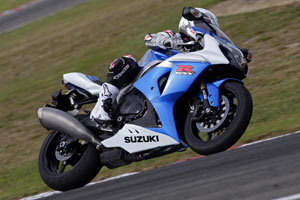
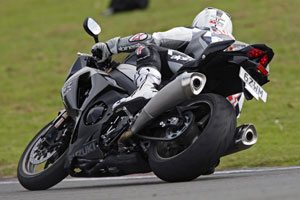
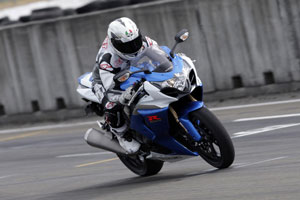

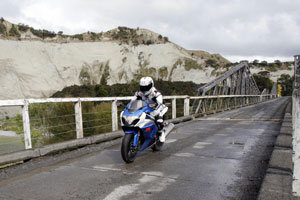
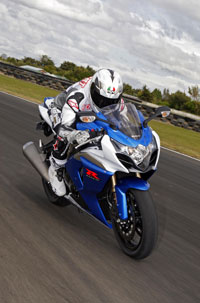





Newsletter